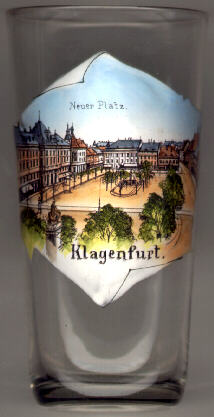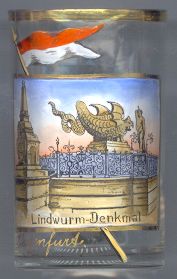

|
| ÖSTERREICH | AUSTRIA |
| Bundesland: Kärnten | Carinthia |
| Stadt: Klagenfurt am Wörthersee |
The history of Klagenfurt began with the foundation by Hermann I von Sponheim, Duke of Carinthia, of a settlement at the river Glan to the north of today's town. This settlement was first mentioned as a market town in 1193. Between 1246 and 1252 Duke Bernhard von Sponheim founded a new settlement further south at the crossroads of two important trading routes, the road from Völkermarkt in the east to Villach in the west and from Friesach and Sankt Veit an der Glan in the north to the Loibl pass in the south. This settlement was first mentioned as a town in 1279. After a devastating fire in 1514 Emperor Maximilian I gave the town to the Provincial Estates of Carinthia in 1518. Since then, Klagenfurt am Wörthersee is the capital of Carinthia (prior to that date it had been St. Veit an der Glan). Between 1534 and 1594 the town was enlarged and new fortifications were built (these were pulled down by the French army in 1809/1810 after the Peace of Schönbrunn). After the rise of Trieste as major sea port of the Austrian Monarchy Klagenfurt am Wörthersee became an important economic centre. The bishops of Gurk transferred their seat to Klagenfurt am Wörthersee in 1786. The 19th century brought the development to a modern town. In 2007 the city council of Klagenfurt am Wörthersee decided to rename the city Klagenfurt am Wörthersee, with the intention to increase the marketing value of the name. Critics objected that this was not well-founded in historical terms because it was only in the 20th century that the city purchased the area between the city and the lake.

During the enlargement of the town in the 16th century the new town centre
moved from the so-called Old Square to the
 New
New
The  monument for Empress Maria Theresia [left, no. 064: bottom left]
was erected on the New Square in 1870 and replaced a previous monument of Balthasar Moll from 1765.
The picture on the glass shows the New Square looking east and the monument is shown
at its old location in the western part of the square. Today, the monument is located
at the western end of the square.
monument for Empress Maria Theresia [left, no. 064: bottom left]
was erected on the New Square in 1870 and replaced a previous monument of Balthasar Moll from 1765.
The picture on the glass shows the New Square looking east and the monument is shown
at its old location in the western part of the square. Today, the monument is located
at the western end of the square.

The famous  Lindwurmbrunnen (Dragon Fountain) [right, no. 1941]
is the landmark of Klagenfurt am Wörthersee. The Lindwurm, a winged serpent or dragon, already appeared
in the town seal in 1287. The name of Klagenfurt am Wörthersee usually is interpreted as
having the origin 'ford of lament' as the bridges across the river Glan were frequently
destroyed by floods. In medieval times floods were often depicted as dragons, which
was the origin of popular tales that actual dragons caused all the damages.
The sculpture of the Lindwurm was begun by Ulrich Vogelsang in 1582
and was completed by his brother Andreas Vogelsang in 1590. The head of the figure
is shaped on the model of the skull of a wooly rhinoceros from the Ice Age which had been found
near Klagenfurt am Wörthersee in 1335. The skull is still exhibited in the museum of Klagenfurt am Wörthersee today.
The Lindwurmbrunnen can thus also be seen as the first attempt of
a palaeontolgical recunstruction. It is cut out of one single block of massive slate.
In 1624 the sculpture was transformed into a fountain. In 1636 the statue of Herkules was added to the fountain.
It was made by Michael Hönel who also created the monumental haigh altar in the cathedral of Gurk.
Lindwurmbrunnen (Dragon Fountain) [right, no. 1941]
is the landmark of Klagenfurt am Wörthersee. The Lindwurm, a winged serpent or dragon, already appeared
in the town seal in 1287. The name of Klagenfurt am Wörthersee usually is interpreted as
having the origin 'ford of lament' as the bridges across the river Glan were frequently
destroyed by floods. In medieval times floods were often depicted as dragons, which
was the origin of popular tales that actual dragons caused all the damages.
The sculpture of the Lindwurm was begun by Ulrich Vogelsang in 1582
and was completed by his brother Andreas Vogelsang in 1590. The head of the figure
is shaped on the model of the skull of a wooly rhinoceros from the Ice Age which had been found
near Klagenfurt am Wörthersee in 1335. The skull is still exhibited in the museum of Klagenfurt am Wörthersee today.
The Lindwurmbrunnen can thus also be seen as the first attempt of
a palaeontolgical recunstruction. It is cut out of one single block of massive slate.
In 1624 the sculpture was transformed into a fountain. In 1636 the statue of Herkules was added to the fountain.
It was made by Michael Hönel who also created the monumental haigh altar in the cathedral of Gurk.
The well-known Austria writer Ingeborg BACHMANN (1926–1973) was
born in Klagenfurt am Wörthersee. One of the most important literary awards for modern literature of Austria, the
Ingeborg-Bachmann-Preis founded in 1977, bears her name.
![[scale]](lineal.jpg)